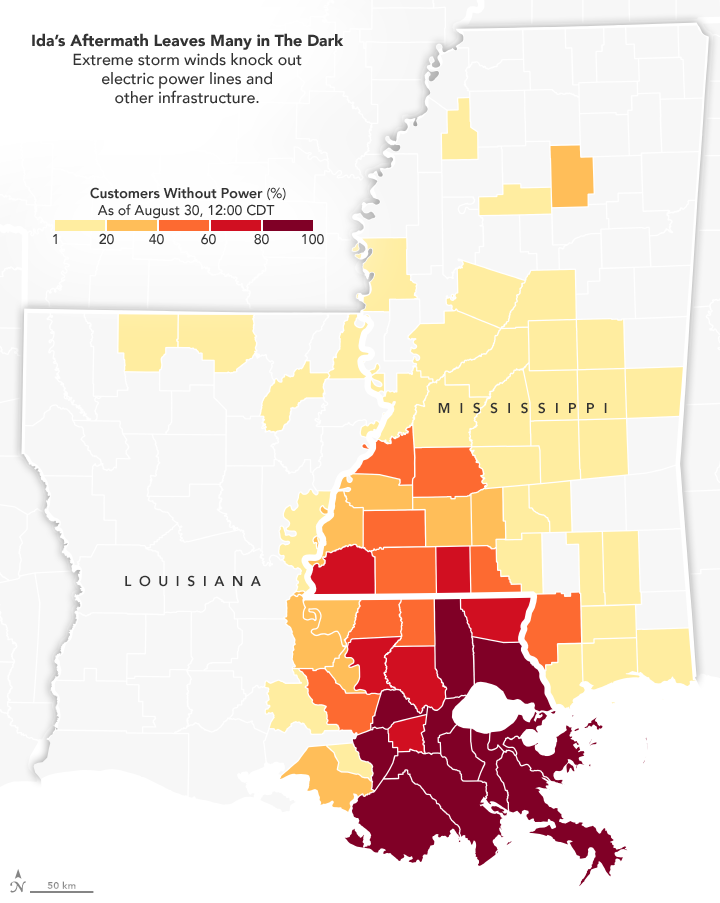Exactly 16 years after Katrina landed, another major hurricane struck South Louisiana. At noon on August 29, 2021, Hurricane Ida rose to the shores of Port Fourchon with winds of 150 miles (240 kilometers) per hour and an average pressure of 930 millibars. Preliminary reports suggests that it is the fifth strongest hurricane (based on wind speed) ever to reach the coast in the United States;
August 30 at 2:50 a.m. Central Daylight Time Visible Infrared Imaging Radiometer Suite (VIIRS) Finnish nuclear power plant the satellite acquired the night view (above) of Hurricane Ida. On the morning of August 29, NOAA GOES-16 satellite data collected for animation intimidation eye wall approaching the coast.
During the last 24 hours before landing, the central pressure of the storm decreased from 985 millibars to 929 the winds intensified rapidly 85-150 miles per hour. According to the National Hurricane Center, the storm has accelerated rapidly as winds increase by at least 35 miles per hour within 24 hours. The intensity was partly increased by the hot summer surface waters of the Gulf of Mexico, which were around 30–31 ° C (86–88 ° Fahrenheit).
The animation above shows the evolution of the east wind field on August 27-30, 2021. The strongest winds appear bright yellow to white; more moderate winds (still stormy winds) are shades of orange and bright purple. Atmospheric data has been run Goddard Earth Observing System Model-5 (GEOS-5), a data assimilation model used by NASA scientists to analyze global meteorological phenomena. The GEOS model collects wind data from more than 30 sources, including ships, buoys, radiosondes, drop probes, aircraft, and satellites. The output of the model is placed in a 0.25 to 0.3 degree grid, so it does not necessarily describe the peaks and extremes of the gusts as measured by individual instruments on the surface.
“For me, the most attractive feature of the East was its rapid intensification until landing,” said Scott Braun, a scientist specializing in hurricanes at NASA’s Goddard Space Flight Center. “The storm was very similar to Hurricane Opal and Hurricane Katrina in the sense that they quickly intensified in the deep warm water area, i.e. the vortex. Gulf Loop current. In addition to providing warm water as fuel, such vortices prevent colder water from mixing with the surface. Such cooling would typically result in attenuation or at least cessation of the storm. Both Opal and Katrina weakened before landing and mitigated the effects of the storms to some extent, although they were apparently still bad. In the East, the deterioration of coastal areas certainly did not happen. “
The hurricane pushed the water wall – the rise of the storm – to Louisiana and Mississippi. Weather stations and the media observed rises between 1 and 3 meters (3 to 9 meters) in places such as Grande Isle, Shell Beach, Lafitte, Barataria, Port Fourchon and Bay Waveland. Port Fourchon on a a major commercial and industrial center For the United States, especially for oil and gas.

The storm lingered in southern Louisiana for most of Aug. 29 and dropped flood-causing rains before moving north and east to Mississippi and Alabama on Aug. 30. The slow pace of the storm may have increased the severe damage to electricity and drinking water infrastructure while delaying the start of clean-up. More than a million customers (businesses, households) in Louisiana had reportedly lost power by August 30th. Another 100,000 customers lost their electricity in Mississippi and 12,000 in Alabama. The map above shows the distribution of power outages in aggregate PowerOeade.US publicly available sources of information.
– I was interested in the East translation speed after landing, ”Hui Su said. which studies hurricanes At NASA’s Jet Engine Laboratory. “There have been studies that have talked about how global warming is causing a slowdown in tropical cyclones, which can contribute to more floods and floods. (Hurricanes Harvey and Dorian, for example.) Discussions are still ongoing because of the quality of historical data, but climate model simulations show that the rate of turn of hurricanes decreases as global warming. “
NASA Earth Observatory imagery and video by Joshua Stevens, using VIIRS day-night lane data Finland’s national Polar touring partnership, GEOS-5 information Global modeling and assimilation agency NASA’s GSFC and power outage information PowerOrite.us. Story: Michael Carlowicz.

